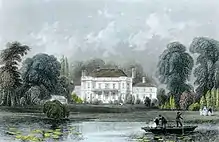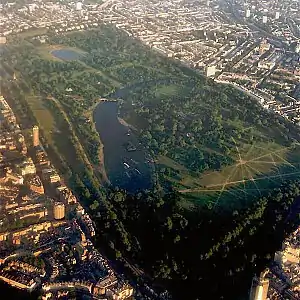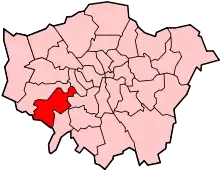Barn Elms
Barn Elms is an open space in Barnes in the London Borough of Richmond upon Thames, located on the northerly loop of the River Thames between Barnes and Fulham.

The WWT London Wetland Centre (105 acres of what were once reservoirs) lies to the north of the open space, now largely given over to sporting venues. The site is split in two: the Barn Elms Playing Fields[1] (managed by the London Borough of Richmond upon Thames) and the Barn Elms Sports Centre[2] (managed by the London Borough of Wandsworth) which includes a boathouse as well as a sports centre. Beverley Brook flows across the southern part of the open space, joining the Thames almost opposite Craven Cottage.
Barn Elms Sports Trust
There are facilities for much amateur sport, such as football, rugby, tennis, softball and cricket, and an athletics track. It is also the home ground for Barnes Eagles FC,[3] Stonewall FC,[4] London French RFC.[5] and London Exiles RFC.[6] The facilities were under threat of commercial development until the local community petitioned Richmond Council. To ensure the future of Barn Elms as playing fields the community has created the Barn Elms Sports Trust.[7]
In April 2013, Barn Elms Sports Trust were officially awarded the management contract of the Barn Elms Playing Fields following a 12-month interim management period. During this time, substantial improvements were made in the form of a new London Marathon Pavilion with eight changing rooms, a community room, a grounds shed, a car park, six tennis courts, four cricket nets and new playing fields.
Barn Elms Sports Centre[8] is a fifty-two acre, multi-sports facility, which hosts the Elms Gym, twenty tennis courts, AstroTurf playing surfaces and a whole range of grass sports pitches including football, rugby, cricket and softball. It is also the home ground for the semi-professional Barnes RFC.
History

Its name is derived from the Georgian house and parkland, the original manor house of Barnes, which stood on the site, until it was burnt out and demolished in 1954.[9] In earlier times the manor house of Barnes was in the ownership of the Archbishop of Canterbury and then of the Dean and Chapter of St Paul's Cathedral. The Georgian house replaced the earlier one occupied by Sir Francis Walsingham, "Elizabeth's Spymaster".[10] Queen Elizabeth I would visit Barn Elms to see her Spymaster. Barn Elms features in English literary history from the time the royalist poet Abraham Cowley moved to the house belonging to John Cartwright in 1663.[11]
In the 1660s Barn Elms became a fashionable destination for boating picnics. Samuel Pepys, who arranged many a Sunday afternoon or moonlit evening boating party to Barn Elms himself, recorded that on 26 May 1667:
I walked the length of the Elmes, and with great pleasure saw some gallant ladies and people come with their bottles, and basket, and chairs, and form,[12] to sup under the trees, by the water-side, which was mighty pleasant.[13]

The oldest, and one of the largest London plane trees[14] in the city is located at Barn Elms, dating to the 1660s. It is listed as one of the Great Trees of London and has become known as 'Barney'.
When Barn Elms was in the possession of the bookseller Jacob Tonson, the Kit-Cat Club met at Barn Elms for many years. Here the "Kit-Kat portraits" hung;[15] Tonson's extensions to the house, c1703, seem to have been made under the general advice of John Vanbrugh, a Kit-Kat member.[16] During Tonson's tenure, John Hughes wrote a poetical description of sunrise in "Barn-Elms":
Let Phoebus his late happiness rehearse,
And grace Barn-Elms with never-dying verse !...
Ye verdant Elms, that towering grace this groveBe sacred still to Beauty and to Love !
John James Heidegger, the opera impresario, resided at Barn Elms, where he entertained George II, and as Heidegger's guest Georg Friederich Handel stayed here at his first arrival in England, in 1711.[17]
The house was later remodelled or rebuilt for Sir Richard Hoare, who died at Barn Elms,[18] and enlarged in the early 19th century by his son, Richard Colt Hoare. When Hammersmith Bridge was erected in 1824–27, the company that undertook the work bought Barn Elms and drove the access road, Upper Bridge Road, now Castelnau, across the park.[19] The house was also the home of Sir Lancelot Shadwell, who was Vice Chancellor of England in the 19th century: on one occasion he delivered an injunction while up to his neck in the cool lake.[20] From 1883 to 1939 Barn Elms was used as the club-house of the Ranelagh Club,[21] with polo grounds and extensive gardens.
More recently the site was the home of Ham Polo Club. Over 100 years ago it hosted Fulham F.C. home games. In 1891 Barn Elms for a short time played host to Queens Park Rangers. The club was forced to move there after it became impossible to play soccer at their home ground in Brondesbury which was shared with London Scottish rugby club.[22] The house became derelict and was demolished following a fire in 1954.[23]
References
- "Barn Elms Playing Field". London Borough of Richmond upon Thames. Archived from the original on 4 March 2012. Retrieved 23 October 2010.
- "Barn Elms Sports Centre". London Borough of Wandsworth. Retrieved 23 October 2010.
- Barnes Eagles FC website
- Stonewall FC website
- London French RFC website
- London Exiles website
- Barn Elms Sports Trust
- Barn Elms Sports Centre
- Christopher Hibbert Ben Weinreb, John and Julia Keay, The London Encyclopaedia, 3rd ed, 2011.
- Robert Hutchinson, Elizabeth's Spymaster: Francis Walsingham and the Secret War That Saved England, 2007.
- Cartwright advertised the house "to let" in 1659 (Colovin 1995, s.v. "Marshall, Edward".
- A trestle table.
- Pepys, Diary, 26 May 1667; see also under 5 August 1666, 28 April, 9 June, 21 July and 25 August 1667; 23 March and 2 August 1668.
- "London's best trees". Evening Standard. Retrieved 9 September 2018.
- Victoria County History: Surrey, vol. 4: Barnes; Harry M. Geduld, Prince of publishers: a study of the work and career of Jacob Tonson, 1969.
- Howard Colvin, A Biographical Dictionary of British Architects, 1600–1840, 3rd ed. 1995, s.v. "Vanbrugh, John".
- Barrett 1884:27.
- George Lipscomb, The History and Antiquities of the county of Buckingham 4, 1847:390
- Victoria County History: Surrey, vol. 4: Barnes
- Barrett: 1884:29f.
- They were removed from Ranelagh Ground, Fulham (Barrett 1884:33)
- Macey, Gordon The Official History of Queens Park Rangers Football Club (London : Queens Park Rangers F.C, 1999)
- C. J. Barrett, The History of Barn Elms and the Kit Cat club: now the Ranelagh Club, 1889.

